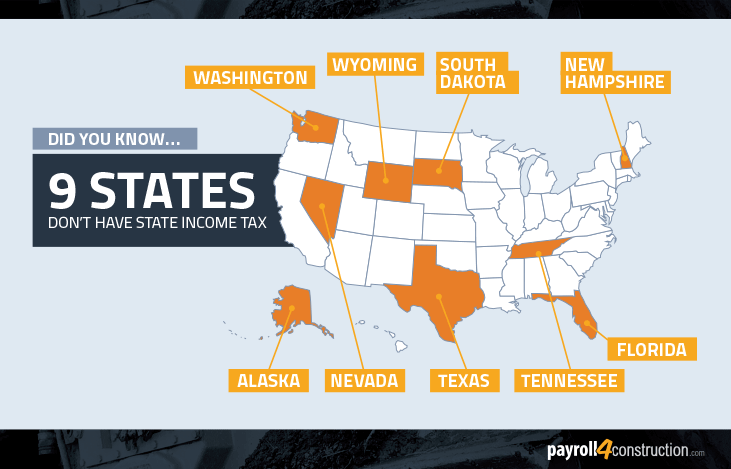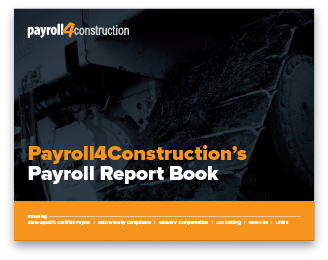
by Alex Gray
July 10, 2017
How to Cross the Border: Taking on Multi-State Taxes Like a Pro
by Fred Ode
In a construction company, you have thousands of moving parts to keep track of at all times — literally and figuratively. Besides maintaining and tracking equipment, bidding, hiring, and managing job sites, construction payroll alone can give you plenty to navigate. Just look at state taxes! And as your business expands across state borders — or as you consider expanding across state borders — understanding how tax regulations can vary from state to state can be, well, taxing.
Your business relationship (or “nexus”) to state tax jurisdictions and the amount owed to them (or “apportionment”) is determined by the overlapping state, federal and other mandates. On the one hand, this can lead to contractors being out of compliance with payroll tax obligations — just as often, it can mean paying more than required to additional tax authorities.
But don’t let that hold you back from taking on out-of-state jobs. The key to success is recognizing some of these common pitfalls and getting help from tax, legal, and construction payroll experts to make sure you’re navigating these issues correctly.
Staying Current is Rule #1
The first key to thriving with multi-state payroll is to stay current. For many contractors, it’s not unusual for employees to work in two to four states on the same payroll. While winning jobs out of state is a good thing, it can quickly make things complicated.
The most challenging aspect of working in multiple states is that each jurisdiction has different rules and regulations for payroll and taxes. On top of that, none of them are written in stone, and they can change at any time. When looking just at the several states that hold potential projects for your company, staying current can be a serious undertaking.
As an example, regulations on recordkeeping can vary from state to state. While some states have no recordkeeping requirements, most require that employers retain records for a minimum of three years. Be sure to learn these requirements before you begin work in a new state — especially if your home state doesn’t have any such requirements. Penalties and fines will also differ from state to state and can include civil penalties, misdemeanor convictions, jail time, and fines from $100 to $10,000.
Additionally, some states hold reciprocity agreements with each other. Reciprocity between two states is an agreement that allows a worker to pay taxes only to the state in which they live. At the time this article was written, Ohio and Pennsylvania have a reciprocity agreement in which Ohio residents who work in Pennsylvania don’t have to pay Pennsylvania taxes.
But these laws change. Pennsylvania and New Jersey had a reciprocity agreement that lasted almost 40 years but ended on January 1, 2017. Suddenly, companies and workers had to pay taxes to both states.
Steer Clear of Double Taxation
Besides keeping up with different regulations, another issue that can arise is double taxation. This occurs when an employee pays taxes twice on the same income — once for State A and once for State B, doubling the amount of income tax they’re paying. Avoiding double taxation requires time and attention to detail.
Employers must make sure that work is being allocated to the correct state on timecards. Employees should carefully check paystubs to verify that their work is being reported to the state in which the job was performed.
At tax time, the employee will have to file a resident state income tax return to report all income, including income earned out of state. They’ll also file a non-resident state income tax return to report only the income earned in that state. Typically, the resident state will give a tax credit for taxes paid on out-of-state work. As a result, the employee will end up paying taxes only once on their income.
Avoiding Overpayment in Unemployment
Along the same lines as double taxation, many contractors unknowingly pay unemployment insurance to the additional states in which they work while only needing to pay their base state. Four factors set by the U.S. Department of Labor should be considered in order to determine where to pay unemployment insurance.
1. Are the services localized? Localized means that the work is performed entirely in one state or that the work performed in additional states is incidental — meaning temporary. For example, a Florida worker receives a request to complete a job in Georgia. The job in Georgia is completed in a few months, and he returns to Florida on his original job. In this case, work is localized to Florida since the work in Georgia was temporary. When work is localized, state unemployment tax (SUTA or SUI) will be paid to that state. If not, consider the next factors.
2. Does a base of operations exist for the employee? When services aren’t localized in one state, determine if there’s a base of operations for that employee. A base of operations can be an office or a place where employees get instructions, receive or repair supplies and equipment, designate mail service, or manage and maintain business records. SUTA or SUI goes to the state where a base of operations is located.
3. Is there a place of direction or control? You might not have a base of operations, but if there’s a location from which you direct or control an employee, taxes for all work performed will be reported to that state.
4. What’s the employee’s state of residence? If there’s no localization, no base of operations, and no center of direction or control, consider the state in which the employee resides.
Once these four factors have been considered, you should have narrowed down the state to which SUTA or SUI will be paid for that employee. Unemployment should typically be paid to only one state per employee. Again, it is always best to consult your payroll or legal expert to confirm that your thought process and decision are correct.
Take Time Now to Avoid Issues Later: A Few Best Practices
Much like many other aspects of business — and life — what can really help to avoid issues with state taxes is being prepared and detailed from the very beginning. Once a job is awarded, research the state tax rules and regulations thoroughly.
Additionally, the more detailed timecards you have, the better. This includes cost codes, trades, and hours worked, broken out by each job. It’s also extremely important to make sure you have job and employee records up to date at all times, especially home addresses. This takes more time upfront but will pay off greatly as you file taxes.
Finally, make sure you have numerous reports available and processes in place to review all of your payroll details before payroll is processed. When running timecards and proofing reports, you may be able to catch mistakes and help avoid issues in the future.
Work With A Company That Knows How To Handle Multi-State Taxes
Having reviewed a handful of multi-state tax issues here, we’ve only scratched the surface when it comes to working in multiple states. However, contractors don’t have to — and shouldn’t — go it alone. Taxation and legal counsel are irreplaceable. Construction-specific CPAs are a must-have for contractors of any size, and along with their professional guidance, a construction-specific payroll service can execute tax-compliant processing without headaches.
Knowing that these multi-state complications exist and how to stay on top of them will help as you navigate payroll and continue to expand your business across state lines. After all, state borders shouldn’t be the boundaries of your business, so cross over and take on those jobs without fear.
*A version of this article was first published by CoatingsPro magazine.
Share Article
Keep on current news in the construction industry. Subscribe to free eNews!


